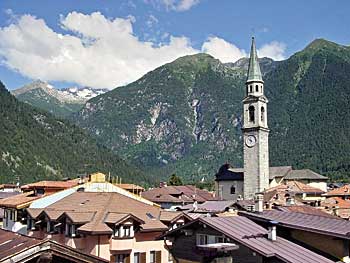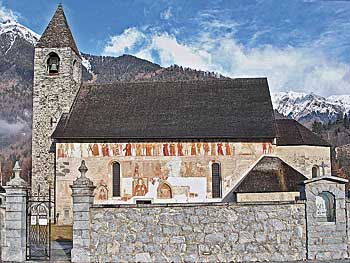MAKING THE DOLOMITES YOUR OWN
Marek Grocholski

Black elder juice at the home of our friends and wonderful frescoes in an old
stone church. Green pastures and rugged white mountains. The scent of
juicy grass in the alpine meadows and the wind in the empty spaces
between the rocks and piles of dolomitic debris. We come from Poland and
this is our first time on the Brenta massif. I'm carefully trying to line up the
words in each sentence, but I'm unable to give voice to the flow of
impressions.
 Our old red Opel crosses the bridge over the river Sarca. Pinzolo is no longer an abstract point on the map. It turns out to be a lively village with streets, houses and people. The milometer shows nearly one thousand two hundred kilometres from Zakopane. The damp heat, the air ripples on the boiling asphalt - "How do you get to via Calvet?" - After the church in the square, turn right. A lively and sprightly old man, but almost dried by the sun, he doesn't limit himself to answering and asks where we've come from. Poland reminds him of World War II. He came to our country as a soldier with the Italian troops allied with the Germans. The difference in historical experience doesn't stop his desire to talk with us. The old man wants to know how old I am. When I tell him my age, he exclaims that at my age he had already been married for some time. He must be no less than ninety years old. Our old red Opel crosses the bridge over the river Sarca. Pinzolo is no longer an abstract point on the map. It turns out to be a lively village with streets, houses and people. The milometer shows nearly one thousand two hundred kilometres from Zakopane. The damp heat, the air ripples on the boiling asphalt - "How do you get to via Calvet?" - After the church in the square, turn right. A lively and sprightly old man, but almost dried by the sun, he doesn't limit himself to answering and asks where we've come from. Poland reminds him of World War II. He came to our country as a soldier with the Italian troops allied with the Germans. The difference in historical experience doesn't stop his desire to talk with us. The old man wants to know how old I am. When I tell him my age, he exclaims that at my age he had already been married for some time. He must be no less than ninety years old.
We're taken by surprise, despite the principles of good education. The hospitality of the master of the house is the most precious thing that exists. Not only the black elder juice, but a hearty lunch, fine wine and coffee, like you can't find in Poland. Far-away places come closer when we meet people like us, with similar thoughts and feelings.
 Genius loci: I believe in it and I’m sure it exists. The example is the church of San Vigilio at Pinzolo. Our guide, a man with a white beard and glasses, is the living element of such a place. He offers us a book he wrote about the church and a cigar that I'm keeping as a souvenir of our meeting. His knowledge leads us through the artistic beauties. He explains, he makes us see. Roman foundations, Gothic ribbed vaults and pointed roof, the form of the Renaissance complex and, above all, the extraordinary frescoes inside and outside. The Dance of Death is impressive, a 16th century oblong-shaped painting on the south facade of the church. You can see the passion with which the artist, Simon Baschenis, depicted the idea of equality among men (more than two hundred years before the French Revolution). Genius loci: I believe in it and I’m sure it exists. The example is the church of San Vigilio at Pinzolo. Our guide, a man with a white beard and glasses, is the living element of such a place. He offers us a book he wrote about the church and a cigar that I'm keeping as a souvenir of our meeting. His knowledge leads us through the artistic beauties. He explains, he makes us see. Roman foundations, Gothic ribbed vaults and pointed roof, the form of the Renaissance complex and, above all, the extraordinary frescoes inside and outside. The Dance of Death is impressive, a 16th century oblong-shaped painting on the south facade of the church. You can see the passion with which the artist, Simon Baschenis, depicted the idea of equality among men (more than two hundred years before the French Revolution).
Gruppo di Brenta (Group of Brenta). High mugo pines high on both sides of the path. We climb with difficulty with heavy backpacks on our shoulders. We run into a kind of saddle in the cross-cutting bulge that closes the valley. The forest thins out and before us a gently rippling green basin opens up, hit by sunlight and covered with soft grass. Around it stand the walls of the Dolomites, white, gray, beige, rust. With heights that run from a few hundred to several thousand metres. Val di Sacco (Sack Valley): the name describes the reality well.
 We’d like to stay here. But how to find a water spring? We enter a small rocky valley whose shape suggests that a stream might flow here. A great big marmot watches us from afar and with a shrill whistle warns the other marmots that people that are coming. Actually, we don’t find the water but after passing a grassy blister we find ourselves facing a huge flock of at least 50 goats. When they see us, the animals move like a cavalry brigade ready for battle. With a pirouette, one section turns around, the other lines up in battle array, as if it had decided to gore us. We’d like to stay here. But how to find a water spring? We enter a small rocky valley whose shape suggests that a stream might flow here. A great big marmot watches us from afar and with a shrill whistle warns the other marmots that people that are coming. Actually, we don’t find the water but after passing a grassy blister we find ourselves facing a huge flock of at least 50 goats. When they see us, the animals move like a cavalry brigade ready for battle. With a pirouette, one section turns around, the other lines up in battle array, as if it had decided to gore us.
We return to the green basin and find our water on the other side, high on the rocks. The ideal soil for the tent is a grassy expanse surrounded by a circle of white stones. Alongside, in a small hollow, there is a stone table for preparing food. Around us there are several dead branches of pine for the fire, the result of the winter avalanches.
The crevasse is deep and widens towards the bottom. You have to stand on the edge of a glacier (Vedretta di Sacco) and with lengthened steps reach the rock wall. Then climb where the wall becomes a sloping surface covered with fine gravel. This is the worst part. If only we didn’t have to go back the same way. Once we’re high up, it’s not so bad. Solid rock in the shape of large steps or slightly steep well-carved slabs. But we don’t let the euphoria get the better of us and we leave stone markers in case our plan doesn’t work. In the labyrinth of limestone canyons, peaks, perches and sinking tanks it’s easy to lose your sense of direction.
 A steep, fragile but simple cataract. A diagonal street crosses the accumulation of rocky deposits in a ravine and winding trails cut through a rocky gully to a large dark basin. We’ve already been walking for several hours walk. A lunar landscape, there’s not one blade of grass, but stones, strips of snow and, around us, inaccessible peaks around. Here’s our passageway, perhaps we’ll be able to get there. Yesterday we saw it from the other side, the rocky sides that descended on the tourist trail. Maybe someone has passed this way before us, there are boot-shaped footprints on the gravel that covers the stone steps. Taking the western slope, again rather fragile, we get closer to our goal. Impatiently facing up to the last section of unstable rock, I raise my head over the edge of the ridge ... a striking impression, two or perhaps three hundred metres high. We’re somewhere between Cima Padaiola and Cima Padaiola Bassa. From all sides, you see a path, but that’s not all. You also see a crossing with a rocky side, but it’s not reachable from where we are. One thing is clear: we can rely only on the stone markers we’ve left and the help of God. A steep, fragile but simple cataract. A diagonal street crosses the accumulation of rocky deposits in a ravine and winding trails cut through a rocky gully to a large dark basin. We’ve already been walking for several hours walk. A lunar landscape, there’s not one blade of grass, but stones, strips of snow and, around us, inaccessible peaks around. Here’s our passageway, perhaps we’ll be able to get there. Yesterday we saw it from the other side, the rocky sides that descended on the tourist trail. Maybe someone has passed this way before us, there are boot-shaped footprints on the gravel that covers the stone steps. Taking the western slope, again rather fragile, we get closer to our goal. Impatiently facing up to the last section of unstable rock, I raise my head over the edge of the ridge ... a striking impression, two or perhaps three hundred metres high. We’re somewhere between Cima Padaiola and Cima Padaiola Bassa. From all sides, you see a path, but that’s not all. You also see a crossing with a rocky side, but it’s not reachable from where we are. One thing is clear: we can rely only on the stone markers we’ve left and the help of God.
 I won’t describe the descent. I say only that I took a deep breath once we were all back on the snow on the other side of the rocky ravine. I won’t describe the descent. I say only that I took a deep breath once we were all back on the snow on the other side of the rocky ravine.
Two things push you to know the mountains. The first is the contact with the people who live there and their culture. The other is the physical effort seasoned with a pinch of fear, or the contact with nature. In the end I'd say that maybe I made the Dolomites a bit mine - Patrimony of Mankind, therefore also mine.
|
 NUMBER 10
NUMBER 10

 NUMBER 10
NUMBER 10
